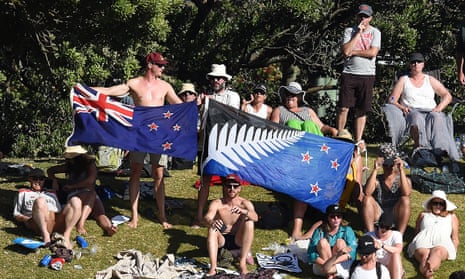New Zealanders’ decision to stick with the status quo in a referendum on the national flag seems to have taken much of the world by surprise, with responses from the delighted to the baffled. But the polls had long pointed to such a result, and it isn’t quite right to say, as countless headlines have, that the country had voted to keep the union jack on the flag. It was altogether more muddled than that.
The motley opponents of the Kyle Lockwood-designed alternative, which came out on top in an earlier run-off referendum, made unlikely bedfellows. Among them were, yes, many conservative-minded voters, set against any idea of jettisoning the emblematic link to the mother country. Alongside them was another group eager to shake off the colonial vestige gobbling up a quarter of the flag, yet unable to stomach the alternative. For them the mishmash Lockwood flag – variously compared to a beach towel, a Weetabix packet and the logo for a chain of budget motels – was such an eyesore that they were driven to plump for the unsatisfactory but less hideous incumbent.
Others were against the alternative flag because they opposed the man most closely associated with it: the centre-right prime minister, John Key. Egged on by the opposition parties, who almost universally denounced this Key legacy project as a distraction, and a waste of NZ$27m, their objective, more or less, was to give the prime minister, unaccustomed to losing anything much, a bloody nose.
As the double-referendum process unravelled, diehard supporters of change and diehard supporters of Key, took turns in attacking the “designerati”, the “liberal elites”, the sufferers of “Key derangement syndrome”. Proxy battles ensued. Intelligent people got stuck in unintelligible rows. There were vexed and protracted debates about whether a rejection of the Lockwood flag would mean giving up any chance of changing the flag for a lifetime.
Heat, for the most part, triumphed over light, and it sometimes became difficult to remember precisely what was being argued about. By the time the postal ballots for the second referendum arrived, it was as if our choice amounted to something much more than pitting this flag against that flag – and at the same time much less.
Along the way, the wider process was bedevilled by problems. The cross-party group tasked with choosing a flag consideration panel failed to appoint a single designer or visual artist – can you imagine, one critic noted, a potential change to the national anthem being overseen by a group without any musicians? – and the nationwide consultation had the feel of a primary school citizenship module.
The flag panel roadshow was attended by a tiny sprinkling of people, some of whom admitted they were only there for the free biscuits. The panel’s ineptitude was confirmed, for many, by their compilation of a shortlist that included three fern-based designs, two of which were identical but for a corner of colour, and a koru – a traditional Maori spiral design – which resembled the rear end of a monkey escaping out of frame, and was quickly dubbed “hypnoflag”.
A big part of the problem with New Zealand’s flag debate – in contrast to the referendums over Scottish independence and Brexit – is that it has been almost by definition superficial. The prime minister, who has described himself as “the biggest constitutional monarchist out”, was very clear that this was to be a debate about a flag, rather than a debate about the – god forbid! – constitution. The fact that New Zealand’s head of state lives in a nice house in London, almost 12,000 miles from our seat of parliament, was never up for discussion.
By chance, this last week, as the final flag ballots were being posted back, the new governor general of New Zealand was appointed. Her name is Dame Patsy Reddy, and she’ll no doubt do a very fine job as the “personal representative” of the New Zealand head of state, Elizabeth II. That position, albeit most days of the week a ceremonial one, was simply announced by the prime minister. There was no show of hands in parliament, let alone a popular vote. And so a flag with Britain looking down on us is just about what we deserve.
